Understanding Your Home’s Hidden Foundation Protector
Weeping tiles in older homes are underground drainage pipes that collect groundwater and carry it away from your foundation to prevent leaks and flooding.
Key facts for vintage properties:
- Purpose: Move groundwater away from the foundation to prevent basement leaks
- Common materials: Clay (pre-1960s), corrugated plastic, PVC
- Typical lifespan: 30–50 years for clay; longer for modern plastics
- Warning signs: Leaks, musty odors, efflorescence, foundation cracks
- Replacement cost: Average basement waterproofing runs about $4K–$8K
Homes built before 1960 commonly have terracotta clay tiles. With time and soil movement, clay can crack, shift, and clog, often finded only after the first flood. Many century homes also have complex drain networks (rain lines, floor drains, even old cisterns), so a failure in one part can redirect water into your basement.
I’m Darin Garvey. For 30+ years in the Philadelphia region, I’ve found most wet basements in older properties trace back to aging or failed foundation drains. The right diagnosis and upgrade restores long-term protection.
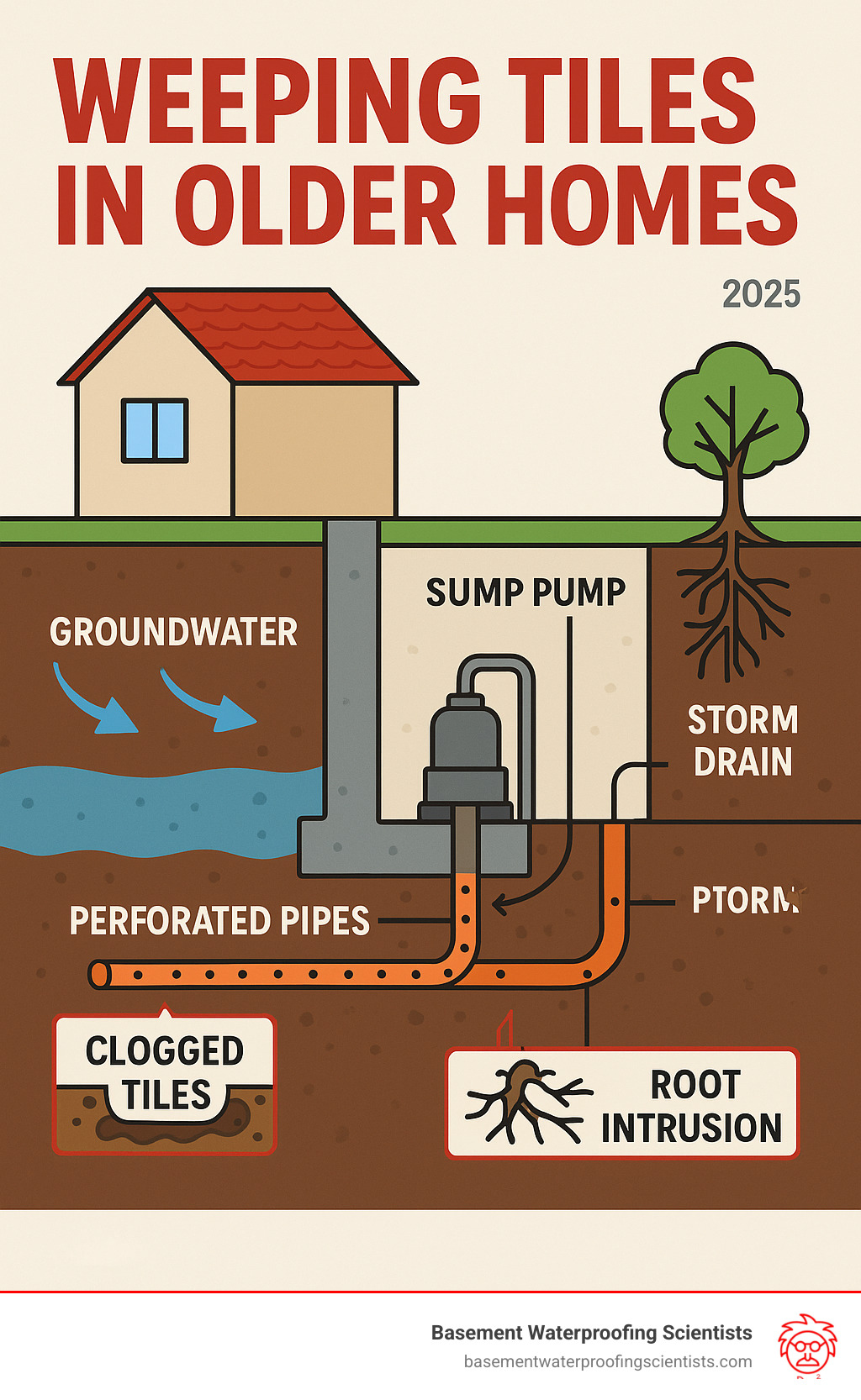
Basic weeping tiles in older homes terms:
The Unseen Guardian: What Are Weeping Tiles and How Do They Work?
Think of weeping tiles (also called drain tiles or French drains) as a hidden moat around your foundation. Perforated pipes sit beside the footings to capture rising groundwater and route it to a sump pump or storm sewer. By relieving hydrostatic pressure, they stop water from forcing through cracks and joints. The concept dates to 1859, credited to Henry Flagg French. Learn more about the history of the French drain. A properly designed Drain Tile system keeps water out and your basement dry.
From Clay to Plastic: The Evolution of Weeping Tile Materials
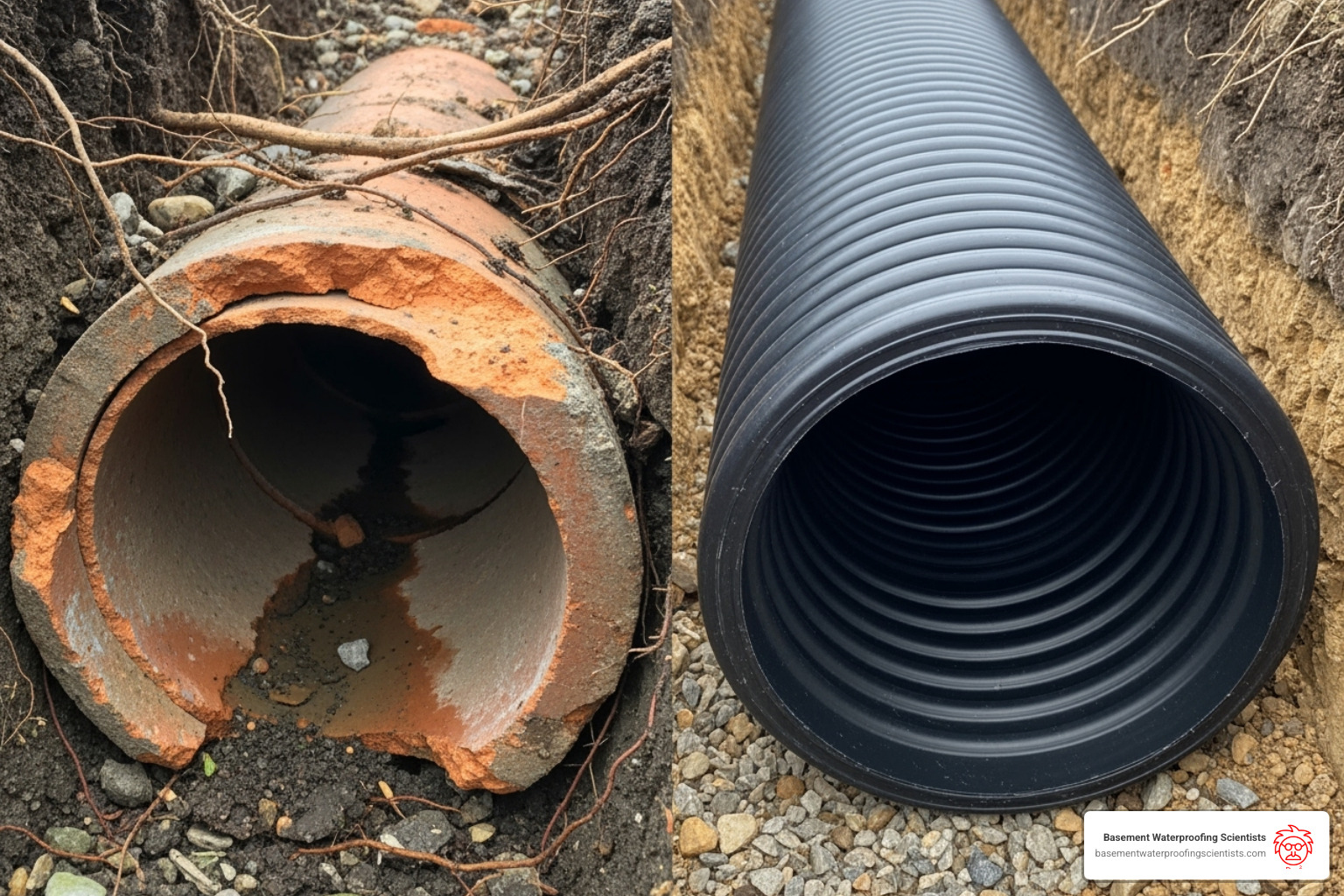
- Terracotta clay tiles (pre-1960s) worked well when new but are rigid and brittle. Decades of movement and freeze-thaw cause cracks, collapse, and silt buildup.
- Bituminous fiber (Orangeburg) proved even less durable, prone to rapid degradation.
- Modern corrugated plastic offers flexibility but can trap debris if misused.
- Smooth-wall PVC is the gold standard: strong, clog-resistant, and long-lasting.
Today’s materials greatly extend service life. While the function of a Tile Drain System is unchanged, the reliability is dramatically improved.
When the Guardian Falters: Signs of Failing Weeping Tiles in Older Homes
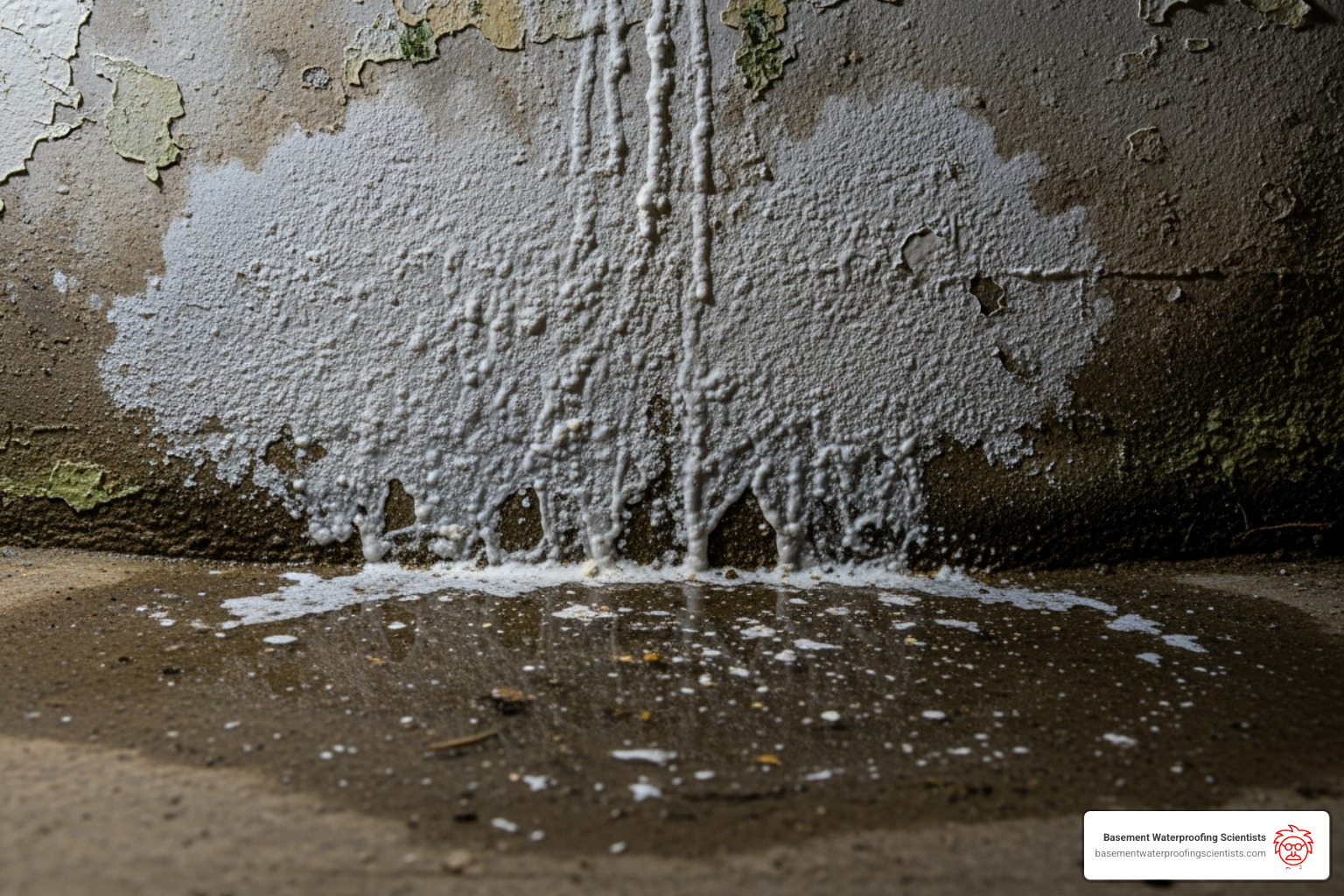
Watch for these red flags:
- Leaks or puddles, especially where wall meets floor, after rain or snowmelt
- Musty odors, mold or mildew growth
- Efflorescence (white, powdery mineral deposits) on walls
- New or widening foundation cracks; bowing walls
- Sump pump that never runs during storms (no water reaching pit) or runs constantly
If your system is 30+ years old and never inspected, it may be near the end of its life. See more in 8 Signs Your Basement Needs Waterproofing.
Why Old Weeping Tiles Fail: Common Culprits
- Root intrusion through joints and cracks
- Silt and soil clogging over decades
- Clay tile degradation, cracking, and collapse
- Shifting soil and settling that open joints or disrupt slope
- Improper original installation (poor slope, inadequate gravel, missing or damaged filter components)
The Domino Effect: Consequences of a Failed System
- Water damage to belongings and finishes; repeated cleanup costs
- Structural movement from persistent hydrostatic pressure (bowing, cracking, settlement)
- Health risks from mold growth
- Lower property value and disclosure headaches
Ignoring drainage failure can turn a $4K–$8K waterproofing job into $20K+ when structural work and mold remediation get added. Early action with professional Basement Waterproofing Solutions prevents escalation.
The Modern Fix: Repairing and Replacing Weeping Tile Systems
Diagnose first, fix once. We use specialized equipment and in-pipe video where possible to pinpoint problems, so we can fix leaks for less. Solutions typically include exterior excavation or interior trenching, removal of failed clay sections, and installation of durable plastic drains. During exterior work, we often add a foundation waterproofing membrane for a second layer of protection. Details: Basement Waterproofing.
Inside or Out? Choosing Between Interior and Exterior Systems
| Feature | Exterior Weeping Tile System | Interior Weeping Tile System |
|---|---|---|
| Pros | Stops water before it reaches the wall; addresses root cause; membrane can be added | Lower cost; no landscaping disruption; year-round installation; fast |
| Cons | Higher cost; excavation and restoration; weather-dependent | Manages water after entry; needs sump; some ongoing maintenance |
| Best Use Cases | New builds; major renovations; severe exterior issues; long-term investment | Limited exterior access; finished yards; tight budgets; quick installs |
| Cost | Higher upfront | Lower upfront |
Exterior systems act like a moat; interior systems act like a perimeter storm drain. Both can be highly effective when designed correctly. We install Interior Drainage System solutions and can integrate a Basement Drainage Channel.
Assessing Weeping Tiles in Older Homes: Repair vs. Replacement
- Spot repairs: Good for isolated damage in relatively young systems.
- Full replacement: Best for widespread failure, especially 30+ year-old clay.
- Plans matter: Long-term owners often benefit from full modern systems. Thinking of selling soon? Targeted repairs may suffice.
Maintenance options and limits: Cleaning Out Weeping Tiles.
Budgeting for a Dry Basement: Understanding the Costs
Typical waterproofing: $4K–$8K. Cost drivers include perimeter length, access, soil, excavation, labor, sump pump needs, and permits. See typical ranges: Drain Tile Installation Cost.
Introduction
Older homes battle groundwater and hydrostatic pressure every season. A properly designed weeping tile system quietly collects and redirects that water away from your foundation to keep basements dry. Below, we explain how these systems work, what fails in vintage properties, and the best modern fixes—without the guesswork or placeholders.
The Unseen Guardian: What Are Weeping Tiles and How Do They Work?
Weeping tiles (drain tile, French drain) are perforated pipes along the footing that collect groundwater and relieve hydrostatic pressure. They discharge to a sump pump or storm sewer, keeping the basement dry. Learn about The history of the French drain and how a modern Drain Tile system protects your foundation.
From Clay to Plastic: The Evolution of Weeping Tile Materials
Terracotta clay and Orangeburg pipe in older homes degrade, crush, and clog. Today’s corrugated plastic and smooth PVC last longer and flow better. See how a modern Tile Drain System improves reliability.
When the Guardian Falters: Signs of Failing Weeping Tiles in Older Homes
Common signs include basement leaks after rain, musty odors, mold, efflorescence, wall cracks, and a sump pump that never runs (or runs constantly). More signs: 8 Signs Your Basement Needs Waterproofing.
Why Old Weeping Tiles Fail: Common Culprits
Root intrusion, silt clogging, clay tile collapse, shifting soil, and improper installation (including damaged filter components).
The Domino Effect: Consequences of a Failed System
Water damage to contents and finishes, structural stress (bowing, settlement), health risks from mold, and reduced resale value. Avoid escalation with professional Basement Waterproofing Solutions.
The Modern Fix: Repairing and Replacing Weeping Tile Systems
A professional inspection with specialized tools and video cameras pinpoints issues so we can fix leaks for less. Typical solutions include installing modern plastic drains and adding a foundation waterproofing membrane where appropriate. Learn more: our Basement Waterproofing page.
Inside or Out? Choosing Between Interior and Exterior Systems
- Exterior: Stops water before it reaches the wall; higher upfront cost; excavation required.
- Interior: Lower initial cost; installed year-round; manages water via sump pump.
See options like our Interior Drainage System and Basement Drainage Channel.
Assessing Weeping Tiles in Older Homes: Repair vs. Replacement
Spot repairs work for isolated problems; 30+ year-old clay systems often need full replacement. If you are staying long-term, a full upgrade is a smart investment. Maintenance reference: Cleaning Out Weeping Tiles.
Budgeting for a Dry Basement: Understanding the Costs
Typical waterproofing ranges $4K–$8K, depending on access, soil, footage, labor, sump needs, and permits. Pricing guide: Drain Tile Installation Cost.
Beyond the Tile: A Holistic Approach to Drainage in Older Homes

Foundation drains work best when surface water is controlled:
- Gutters and downspouts: Keep clean; extend at least six feet away.
- Yard grading: Slope soil away from walls.
- Window wells: Add covers to prevent pooling.
Some historic homes include old cisterns that affect drainage; learn more about the role of cisterns in historic homes.
Proactive Protection: Maintaining Your Home’s Drainage
- Clean gutters every spring and fall.
- Verify downspout extensions and clear discharge paths.
- Regrade low spots near the foundation.
- Test the sump pump quarterly.
Understand all components, including What Exactly Does a Basement Floor Drain Do?.
Frequently Asked Questions about Weeping Tiles in Old Houses
How long do clay weeping tiles last in an older home?
Typically 30–50 years, affected by soil, freeze-thaw cycles, and installation quality. Original pre-1960s systems are often beyond intended life and should be inspected.
Can you clean out old weeping tile systems instead of replacing them?
Sometimes. High-pressure flushing may clear minor silt if pipes are sound, but fragile clay can collapse. Always start with a camera inspection. Severe damage, collapse, or major root intrusion typically requires replacement. Related reading: when a Basement Drain Has Standing Water.
Is an interior weeping tile system as good as an exterior one?
They work differently. Exterior systems prevent entry (the gold standard). Interior systems manage water that reaches the foundation and route it to a sump. For many older homes, an interior French Drain in Basement is practical, effective, and cost-efficient.
Conclusion
Weeping tiles are the quiet protectors of vintage foundations, but clay systems often reach the end of their service life after a few decades. Do not wait for the next flood. A professional assessment is the first step to a permanently dry basement.
Basement Waterproofing Scientists brings 30 years of experience, specialized leak-source equipment, competitive pricing, and a lifetime guarantee. Typical waterproofing runs $4K–$8K—far less than repeated water damage or structural repairs. Explore our Basement Drain Systems and protect your home’s value.
Understanding Your Home’s Hidden Foundation Protector
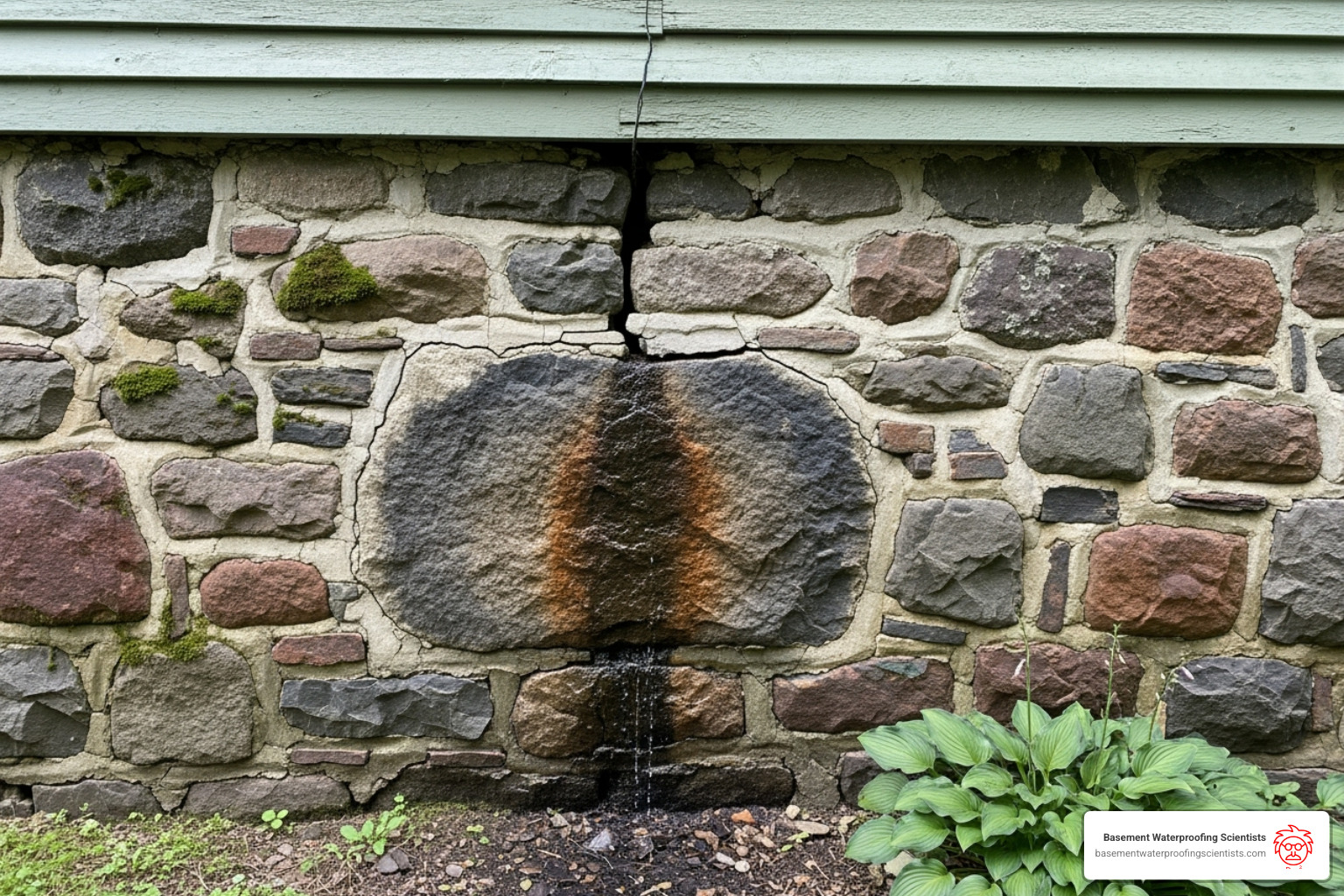
That damp spot may be your foundation asking for help. Weeping tiles in older homes collect groundwater and redirect it away to prevent flooding. Pre-1960s systems typically used clay with a 30–50 year lifespan; age, cracks, and silt can leave your basement vulnerable. Typical waterproofing projects cost $4K–$8K—small compared with mold or structural repairs. I’m Darin Garvey; after 30+ years in the Philadelphia area, I know a proper inspection is the fastest path to a dry basement.
Basic weeping tiles in older homes terms:
The Unseen Guardian: What Are Weeping Tiles and How Do They Work?
Weeping tiles (drain tile, French drain) are perforated pipes at the footing that intercept groundwater and route it to a storm sewer or sump pump, relieving hydrostatic pressure and protecting your foundation. Read more about Henry Flagg French, who popularized the idea in 1859: Drain Tile.
From Clay to Plastic: The Evolution of Weeping Tile Materials
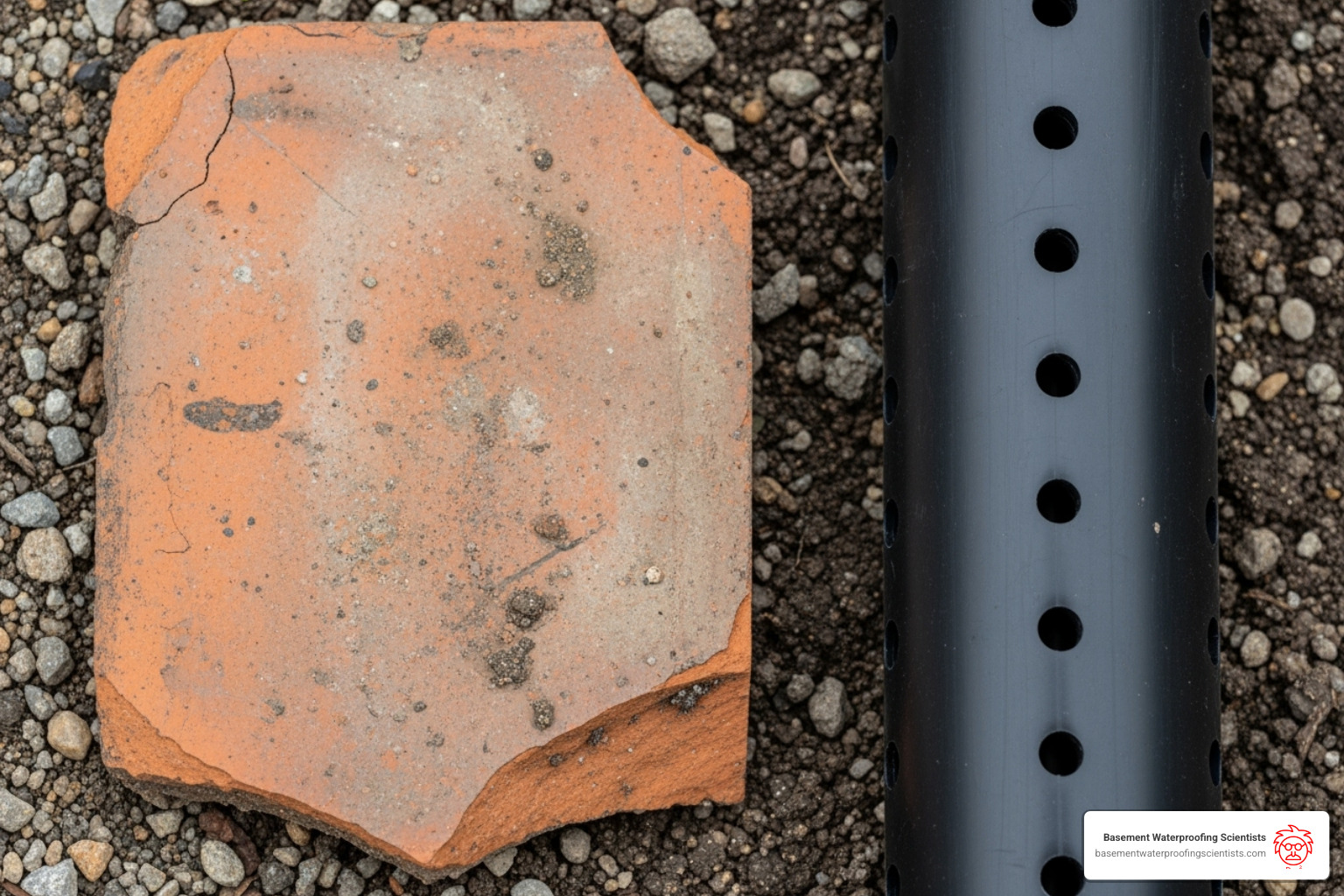
Clay and Orangeburg degrade; modern corrugated and PVC systems are tougher and flow better. Smooth-wall PVC resists crushing and clogging and offers decades of service. Learn how a modern Tile Drain System extends protection.
When the Guardian Falters: Signs of Failing Weeping Tiles in Older Homes
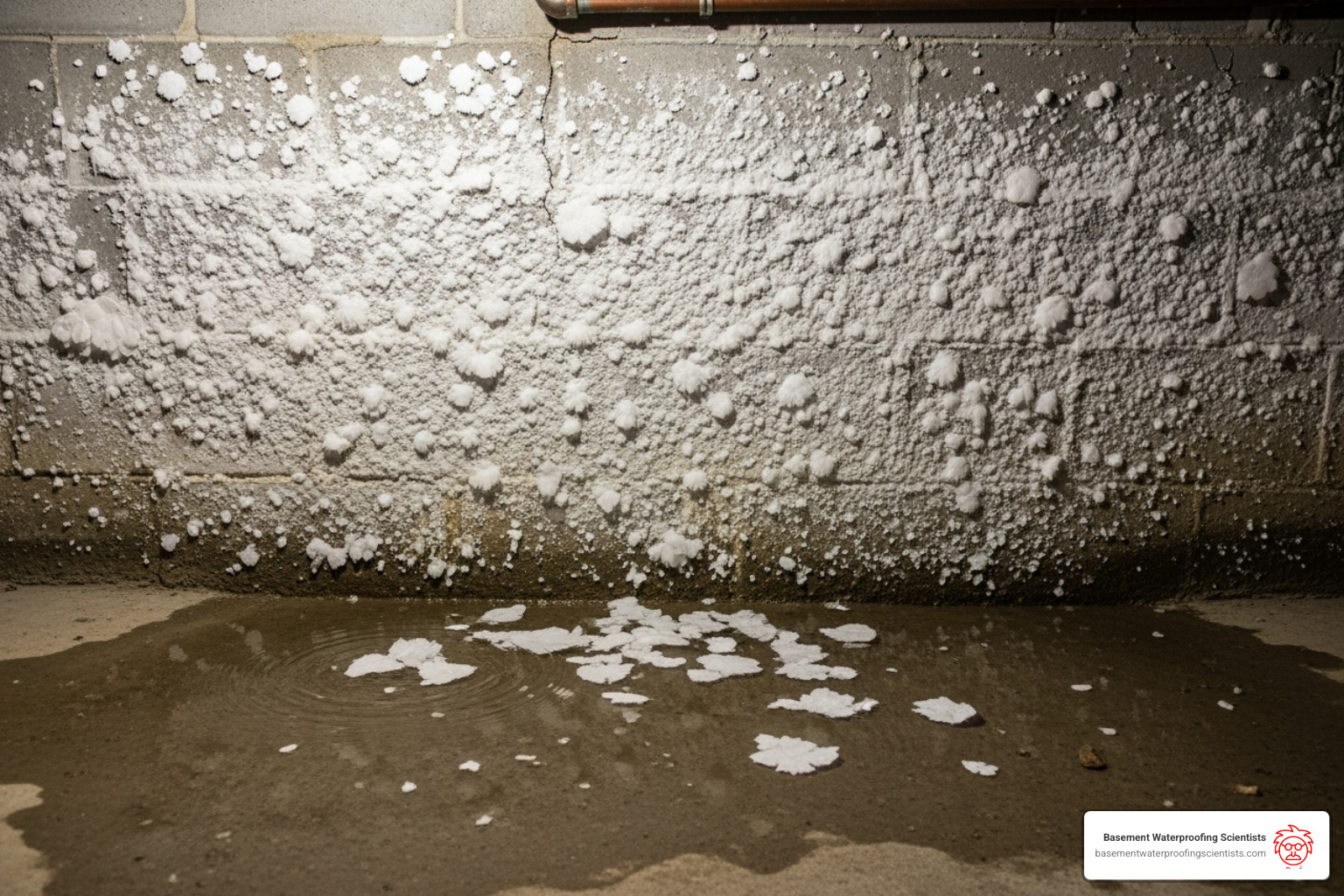
Watch for leaks after storms, musty odors, efflorescence, new cracks or bowing, and odd sump pump behavior. Causes include silt clogging, clay tile collapse, roots, and soil movement. Waiting can multiply costs. See 8 Signs Your Basement Needs Waterproofing and explore Basement Waterproofing Solutions.
The Modern Fix: Repairing and Replacing Weeping Tile Systems
We start with a targeted inspection and, when possible, a video look inside the pipes. Depending on access and budget, we install new plastic drains via exterior excavation (with optional wall membrane) or an interior trench that feeds your sump. Learn more on our Basement Waterproofing page. Interior options include an Interior Drainage System and Basement Drainage Channel. Spot repairs are possible for localized issues; older clay systems often warrant full replacement. Budget guidance: Drain Tile Installation Cost.

